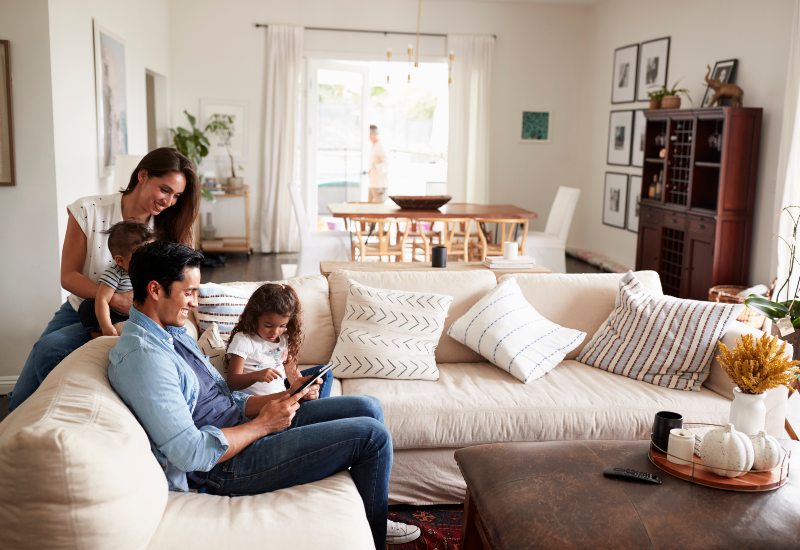
While you’re busy making your home a sanctuary, it’s easy to forget about the invisible yet crucial aspect of indoor air quality. The Environmental Protection Agency (EPA) estimates that most people in the United States spend 90% of their time indoors. With this information in mind, understanding and improving the air you breathe indoors should be a top priority.
Why Does Indoor Air Quality Matter?
Indoor air quality (IAQ) is more than just a buzzword—it’s a crucial component of a healthy living environment. After all, long-term exposure to indoor pollutants can lead to a range of health problems, from respiratory issues and allergies to headaches and fatigue. It can even exacerbate existing conditions like asthma and chronic obstructive pulmonary disease (COPD). The need for indoor air quality services has never been greater, especially for those who now work or attend school from home.
Dangerous Indoor Air Pollutants
Several indoor air pollutants can negatively affect your health:
- Carbon monoxide is a colorless, odorless gas that can be fatal in high concentrations.
- Biological contaminants, including mold, pollen, and pet dander, can aggravate allergies and asthma.
- Radon is a naturally occurring radioactive gas that rises from the soil and can accumulate in basements. It’s the leading cause of lung cancer among non-smokers.
- Volatile Organic Compounds (VOCs) include a wide range of chemicals. Many household products emit VOCs. For example, formaldehyde is commonly found in furniture and can irritate the eyes and throat.
- Tobacco smoke contains over 7,000 chemicals, including 250 known to be harmful and at least 69 that cause cancer. Inhaling secondhand smoke can be just as dangerous as smoking.
- Pesticides, herbicides, and other chemicals used indoors contribute to poor air quality.
- Asbestos is primarily found in older buildings. The fibers can be harmful if inhaled.
- Lead particles are found in paint in older homes. They can cause neurological issues when ingested or inhaled.
What Causes Indoor Air Pollution Levels to Rise?
Understand what causes increased indoor air pollution so you can begin finding indoor air quality solutions. Here’s what to be aware of:
- Air-tight building construction is intended to improve energy efficiency, but it also traps pollutants inside.
- Poor ventilation limits fresh air intake, allowing trapped pollutants to accumulate.
- Building materials and personal products like paint, cosmetics, and cleaning agents can emit harmful VOCs.
- High humidity encourages mold growth and allows dust mites to thrive.
- Poorly maintained air conditioning systems can lead to a buildup of contaminants that enter your indoor air every time the AC turns on.
- Pet dander, the dead skin cells shed by dogs, cats, and other mammals, trigger allergic reactions in sensitive individuals.
Best Ways to Improve IAQ
The EPA recommends three primary ways to protect your home and family against the effects of poor indoor air quality. These include source control, improved ventilation, and air cleaners. Here’s how to implement each technique.
Source Control
One of the most straightforward and cost-effective ways to improve indoor air quality is to eliminate the source of the contamination. For instance:
- Keep the windows closed when the humidity level or pollen counts are high.
- Make your bedroom a pet-free zone so dander stays out of your pillows, mattress, and bedding.
- Control the humidity level to keep mold and dust mites at bay. Techniques include drying window sills when condensation appears, repairing plumbing leaks promptly, and line-drying clothing outside.
- Consider replacing gas-burning appliances with electric models to eliminate the risk of carbon monoxide leaks.
- Reduce your exposure to VOCs. Look for low- or no-VOC paint, carpet, and furniture when redecorating your home. Also, limit your use of VOC-emitting candles, air fresheners, and aerosols.
- Install a radon mitigation system to prevent this gas from accumulating in your home.
- Ask guests to smoke outside while standing at least 10 feet from windows and doors.
- Remove existing asbestos and lead paint with help from a professional mitigation team.
- Clean regularly using a vacuum cleaner equipped with a HEPA filter to remove trapped dust and particles from the carpet.
Improved Ventilation
Venting stale air to the exterior and bringing fresh outdoor air inside can significantly improve the air quality in your home. Here are some techniques to try:
- Open windows and doors when the weather is nice for natural ventilation.
- Run the bathroom and kitchen exhaust fans when showering and cooking.
- Make sure your dryer vent leads outside, not to the attic or crawlspace.
- Consider a whole-house ventilation system, especially if you live in a newer home with air-tight construction.
- Work in a well-ventilated space when performing pollution-causing activities like painting or woodworking.
- Regularly inspect and maintain household appliances like water heaters, furnaces, and fireplaces to ensure hazardous CO gas is properly vented outside.
- Never use fuel-burning grills, camping stoves, or generators indoors. Even a garage with the door wide open doesn’t provide adequate enough ventilation.
Air Cleaners
Air cleaners or purifiers are designed to minimize pollutants that can’t be controlled at the source or vented outside. The best air cleaners operate efficiently and have a high circulation rate. Portable air cleaners equipped with HEPA filters reduce air contaminants in individual rooms, but whole-house purifiers are recommended for their thorough cleaning power. Just beware of cleaners that produce ozone, a gas that can cause coughing, shortness of breath, and decreased lung capacity in sensitive individuals.
Schedule Indoor Air Quality Solutions
When it comes to safeguarding your indoor air quality, no one does it better than Puget Sound Plumbing and Heating. Our skilled and fully licensed technicians can help you identify the sources of poor IAQ in your home and recommend cost-effective approaches to tackle each one. With over 20 years of experience, we’re focused on delivering unbeatable work and excellent customer service. Ready to breathe easier? Contact us today at (206) 938-3219 to schedule top-notch indoor air quality services in Seattle.


